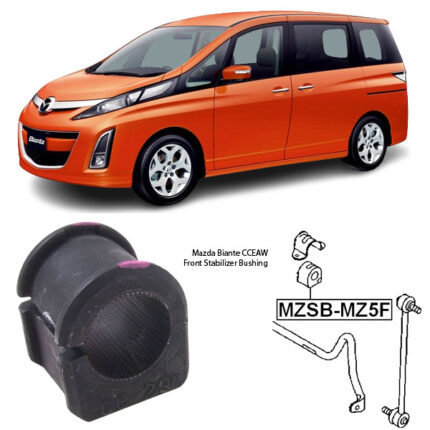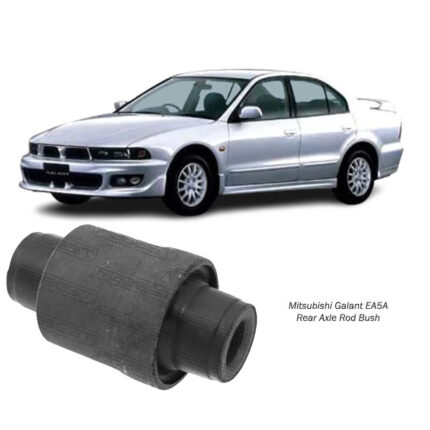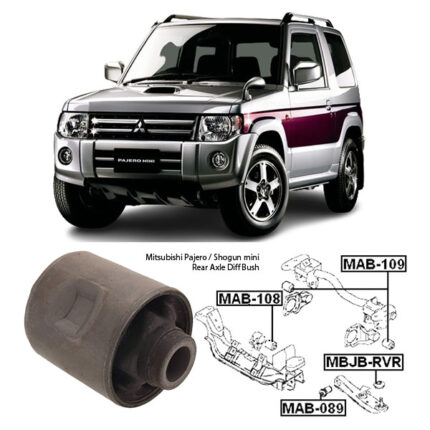Get Mitsubishi Pajero IO Mini Rear Axle Diff Bush MAB-109 in Kenya
The Rear Axle Differential Bush is a vital component in the suspension and drivetrain system of rear-wheel and all-wheel drive vehicles. Its primary function is to secure the rear differential housing to the chassis or subframe while dampening vibrations and absorbing shocks from the road. Though it may appear small and insignificant, this bushing plays a crucial role in maintaining the alignment, stability, and comfort of your vehicle — particularly during acceleration, cornering, and braking.
Over time, this rubber or polyurethane component can wear out, leading to driveline noise, vibration, and even premature wear of the differential itself. Replacing a worn rear differential bush restores proper drivetrain geometry and ensures a smoother, quieter, and more controlled ride.
What is a Differential Bush?
The differential bush is a cushioning mount installed between the vehicle’s rear differential housing and the chassis or subframe. It serves as a link that allows limited movement while preventing harsh metal-to-metal contact. Constructed from rubber, polyurethane, or a combination of both, the bush is designed to flex and absorb torque forces generated by the differential.
Whenever you accelerate or decelerate, the differential shifts slightly due to torque changes. The rear axle diff bush stabilizes this motion, reducing stress on the drivetrain and maintaining vehicle balance.
Key Features of a Quality Rear Axle Diff Bush
-
High-Density Rubber or Polyurethane Construction
Ensures maximum shock absorption while maintaining structural rigidity and longevity. -
Precision Molded for Exact Fitment
Manufactured to OE specifications for a perfect fit and hassle-free installation. -
Steel Sleeve Reinforcement
Inner metal sleeves offer structural support and secure mounting points. -
Resistance to Wear, Heat, and Oil
Engineered to withstand harsh underbody conditions, including road salt, oil, heat, and moisture. -
OEM Quality or Better
Matches or exceeds the performance of original factory-installed bushings.
Functions and Benefits
The rear axle differential bush serves multiple purposes that directly affect vehicle handling and drivetrain health:
-
Vibration Isolation: Absorbs engine and road-induced vibrations, reducing noise and harshness felt in the cabin.
-
Alignment Retention: Maintains correct positioning of the rear differential relative to the driveshaft and rear axles.
-
Load Absorption: Handles torque loads generated during acceleration, deceleration, and gear shifts.
-
Improved Handling: Enhances vehicle stability during cornering and minimizes unwanted movement of the differential.
-
Extended Drivetrain Life: Reduces wear on differential mounts, driveshaft joints, and rear suspension components.
Symptoms of a Worn Rear Diff Bush
Over time, constant exposure to stress, heat, and contaminants can degrade the diff bush. Here are common signs that it may need replacement:
-
Clunking or knocking noise from the rear – Often heard when shifting gears or accelerating.
-
Excessive vibration through the floor or seats – Caused by direct transfer of driveline motion.
-
Drivetrain misalignment – May result in uneven tire wear or stress on other suspension parts.
-
Rough or unstable handling – Especially during cornering or braking.
-
Visible wear or cracking – When inspected during service or repairs.
Ignoring these symptoms can lead to more costly damage to the rear differential, subframe, and other suspension components.
Applications and Compatibility
Rear axle diff bushes are commonly found in rear-wheel-drive (RWD) and all-wheel-drive (AWD) vehicles, including cars, SUVs, and 4×4 trucks. They are widely used across:
-
Toyota (e.g., Prado 120/150, Land Cruiser, Hilux)
-
BMW (especially 3-series, 5-series with RWD setups)
-
Mercedes-Benz, Volkswagen, Ford, Nissan, Isuzu
-
And other performance or utility vehicles with independent rear suspension and separate differentials
Each vehicle may require a specific bush shape, size, and mount type. Always confirm compatibility using the vehicle’s chassis number (VIN) or consult with a parts specialist.
Installation Considerations
Replacing a differential bush often requires mechanical expertise, as the component is typically pressed into the subframe or housing using special tools. In most cases, the process involves:
-
Lifting the vehicle and supporting the rear differential securely
-
Removing the differential mount bolts
-
Extracting the old bushing using a press or bushing removal tool
-
Cleaning the mounting surface to remove debris or corrosion
-
Installing the new bush, often using a hydraulic press or threaded puller
-
Re-torquing all bolts to manufacturer specifications
In some models, it may be necessary to drop the rear subframe or differential carrier for access.
OEM vs Aftermarket Bushes
You’ll find rear axle diff bushes in both OEM (Original Equipment Manufacturer) and aftermarket varieties. Here’s how they compare:
| Feature | OEM Bush | Aftermarket Polyurethane Bush |
|---|---|---|
| Comfort | High (designed for smooth ride) | Moderate to firm |
| Durability | Standard rubber wears faster | Longer-lasting in harsh use |
| Noise/Vibration | Minimal | Slight increase possible |
| Performance | Suitable for everyday driving | Ideal for heavy-duty or off-road use |
Choose based on your driving needs. For daily comfort and original ride quality, go with OEM-style rubber. For performance, towing, or off-road use, consider a polyurethane upgrade.
Why Replace with Quality Bushes?
-
Improved ride comfort
A fresh diff bush helps reduce cabin vibrations and improves ride smoothness. -
Restored vehicle control
Replacing a worn bushing sharpens handling and improves braking response. -
Lower long-term repair costs
Protects other drivetrain components from misalignment and shock damage. -
Peace of mind
No more strange noises, vibrations, or drivetrain thumping when shifting gears.
Follow us on Facebook for more parts.




